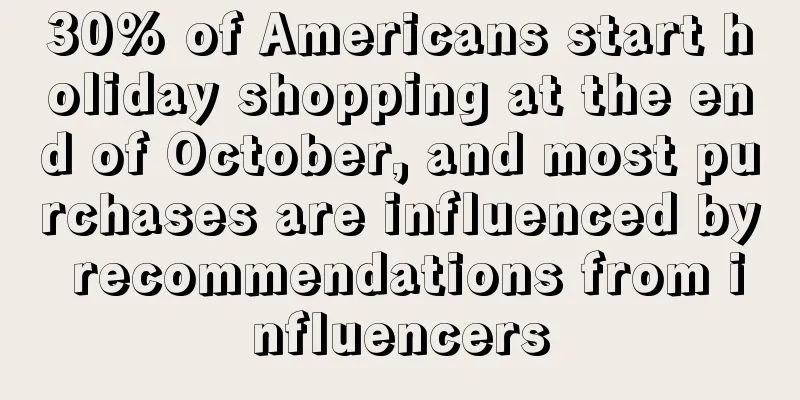30% of Americans start holiday shopping at the end of October, and most purchases are influenced by recommendations from influencers

|
As the various festivals in the second half of the year are approaching, sellers have already sharpened their knives and are ready to go all out. Recently, a consumption trend data from the United States, the main market for sellers, has also been released, which will provide some reference for sellers' sales.
A Jungle Scout survey shows that while most U.S. consumers will wait until November or later to start their holiday shopping, due to product shortages, delivery delays and the continued impact of the epidemic , 31% of U.S. consumers ( hereinafter referred to as "early shoppers") said they will start shopping before the end of October .
Below is an analysis of the purchasing behavior of these early shoppers.
Spend more money on travel this year, and purchase behavior is greatly influenced by social media influencers
According to Jungle Scout’s consumer data, consumers who plan to start holiday shopping early ( before the end of October) have the following characteristics:
1. They will shop online and on social media
Consumers who plan to start holiday shopping early (before the end of October) are primarily shopping online and in-store at major retailers such as Amazon, Walmart and Target. When asked where they plan to buy gift-related products, the majority said they would look online for everything except fitness equipment and alcohol.
This holiday shopping season, about twice as many consumers bought electronics, toys and games online as in stores, many of them at big-box retailers they already frequented.
2. They will seek shopping inspiration from influential people on social media
As for where early shoppers will browse for products, most will turn to traditional search engines like Google or Bing, or go directly to Amazon and Walmart.
Many people also search for products on social media channels, where brands and influencers can market their products through audience engagement posts, detailed product reviews and immersive short videos. Facebook and YouTube lead the way, but Instagram and TikTok are also popular.
Of course, many of those early shoppers are also avid followers of social media influencers in the fashion and beauty fields, with 35% following fashion influencers and 33% following beauty influencers on social media.
Given that 60% of early holiday shoppers say they consider purchasing recommended items when shopping online, much of this year’s holiday shopping will likely be influenced by festive content from brands and influencers on YouTube, Instagram and TikTok.
3. Brand activism could impact holiday shopping
Early holiday shoppers’ purchases may be influenced by brand activism, where brands touch on social issues such as racism and gender expression. Nearly half (48%) of those surveyed view these types of messages from brands positively.
While 42% of early holiday shoppers said brand activism did not influence their opinion of a brand or whether they purchased its products, many did find it had an impact.
Of those, 30% of early holiday shoppers said brand activism has influenced their impressions of brands, while 19% said it has influenced both their purchasing behavior and brand impressions.
And most early holiday shoppers tend to buy from brands that are involved in radical projects in one way or another, whether it's environmentally friendly practices and local sourcing, treating employees fairly, or charitable giving.
In today’s climate of political divisions, accelerating climate change, and issues surrounding gender equality, early adopters are likely to spend their money on brands that support these and other issues. Examples include Nike’s “Just This Once, Don’t Do It” campaign and Organic Foundation’s sustainably produced apparel and low-impact e-commerce sites.
4. They will use contactless payments and other high-tech e-commerce tools
Like most consumers, these early shoppers tend to pull out their physical wallets when making purchases, opting to pay with debit, credit or cash. But the use of tech-forward payment methods such as digital wallets and even cryptocurrencies is increasing.
When asked how they purchased goods or services this year , 31 % said they used contactless payments through a mobile app or digital wallet (such as Venmo, PayPal or Apple Pay) , 16 % used an NFC- enabled physical card for contactless payments , 12% chose to pay on their phone after scanning a QR code , and 11% used cryptocurrency, such as Bitcoin .
Additionally, early shoppers are beginning to adopt digital shopping methods for both money savings and convenience, with nearly half (49%) using browser extensions or plug-ins to search for deals when shopping online , 52% preferring to shop at retailers that offer flexible payment options, such as buy now, pay later or cryptocurrency , and 45% preferring to shop at retailers that offer subscription services, such as Blue Apron, Stitch Fix, ClassPass and Netflix .
5. They will spend more this year
Regardless of which payment method early consumers use, many plan to increase spending during the fall and winter 2021 holidays.
Big year-end events where early holiday shoppers plan to increase spending include: Christmas (36% of early holiday shoppers plan to spend more this year), Thanksgiving (29%), Halloween (27%), New Year’s Eve (24%), Hanukkah (20%), Kwanzaa (17%)
Therefore, it can be expected that consumers will spend more on festive categories such as gifts, decorations, clothing and food.
6. They plan to spend more on travel
In addition to physical goods, many early shoppers may give themselves and their loved ones the gift of travel this year, with 49% having already made plans to travel by the end of 2021 and 33% planning to spend more on travel.
Among early shoppers who are planning a trip, most will choose to drive within the United States , less than half will fly, and as many as a third will choose to travel internationally.
In terms of travel destinations purchased in advance , domestic destinations accounted for 86% , international destinations accounted for 32% , and undecided destinations accounted for 3% .
Many travelers will save money on accommodation by staying with family or friends ( 38%), budget motels (26%) or hotels (17%). On the other hand, more than a third (34%) plan to splurge on a luxury hotel.
After a year of canceled or postponed travel plans due to the COVID-19 pandemic, a new wave of travel could stimulate purchases of luggage, clothing and travel entertainment items.
What impact does consumers ’ early shopping have on e-commerce ?
In a normal year , starting holiday shopping earlier than later offers several benefits , including ample inventory, minimal crowds and a calmer mood . But in the second winter of a global pandemic, early shopping could exacerbate challenges retailers have been dealing with for months.
Early shoppers may still face shipping delays
Even as global supply chains struggle to keep up with the massive demand for online shopping in the U.S., consumers still care about getting fast, free shipping for their online purchases, and early holiday shoppers are no exception.
Buying gifts before the holidays can help avoid delays and out-of-stock situations to some extent , but given the difficulty e-commerce sellers and brands have had in keeping enough inventory in the past 18 months, these issues are not entirely avoidable .
Holiday sales may be reduced or extended this year
Another factor to consider is that the impact of Black Friday and Cyber Monday may be muted this year. These post-Thanksgiving sales events are typically a boon for e-commerce ; last year, Walmart's fourth-quarter sales increased 124% year-over-year, thanks in large part to $76 million in sales on Black Friday. But starting gifting earlier could reduce shoppers' sense of urgency around Cyber Five.
Michael Scheschuk, chief marketing officer at Jungle Scout, noted that retailers will have to face the fact that while Black Friday and Cyber Monday will remain important dates on shoppers’ holiday calendars, they will be “far less important than they were a decade ago.” To attract early shoppers, retailers could simply extend holiday promotions by a few weeks.
Some experts note that brands have less incentive to launch products this year, given that pandemic-induced scarcity could lead to stockouts earlier in the holiday season. So while retailers can run promotions longer, discounts on in-demand products may be reduced.
More local, in-store purchasing may occur
Given early shoppers’ interest in supporting small businesses, brands and retailers that source locally, more of their in-store and online shopping is going to nearby retailers, including those that offer curbside pickup. |
>>: Amazon recalls tabletop fireplace due to lack of label warning
Recommend
What is MailZone Overseas Postcard? MailZone Overseas Postcard Review, Features
MailZone Overseas Postcard is a direct mail automa...
More than 2,000 foreign trade business owners gathered in Guangzhou, and the XTransfer Future Foreign Trade Conference was successfully held
On September 13, under the guidance of the Commer...
What is Intermarché? Intermarché Review, Features
Intermarché is a famous supermarket chain in Franc...
Sales suddenly dropped by 90,000 pieces, sellers: Amazon "stole money"
"Amazon is stealing money," several sel...
Annual loss of 90 million! Dongguan factory announces 3-month holiday
Since the beginning of the year, most cross-borde...
What is TouchnGO eWallet? TouchnGO eWallet Review, Features
TouchnGO eWallet is one of the e-wallets with the...
Furniture giant Wayfair returns with a bang and will restart its physical store business
Wayfair , based in Boston , announced on Tuesday ...
French e-commerce sales exceed 129 billion euros in 2021
Recently, the French National Association of Euro...
What is Keywordspy
Keywordspy is a tool that can search for keyword ...
eBay home improvement category will usher in a shopping boom
According to a survey by eBay Ads, as the deadlin...
What is Seller Chain? Seller Chain Review, Features
<span data-docs-delta="[[20,{"gallery"...
What is ExportHub? ExportHub Review, Features
ExportHub is an international B2B platform. Expor...
What is AMZSharp? AMZSharp Review, Features
AMZSharp is a comprehensive seller tool platform t...
What is Lianwei Logistics? Lianwei Logistics Review, Features
Shenzhen Lianwei Logistics Co., Ltd. was establish...
Christmas season orders will reach 690,000! Shipments will increase by more than 70%
According to foreign media reports, a report rele...









